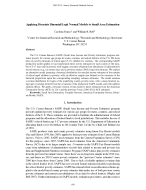
An official website of the United States government
Here’s how you know
Official websites use .gov
A .gov website belongs to an official government organization in the United States.
Secure .gov websites use HTTPS
A lock (
) or https:// means you’ve safely connected to the .gov website. Share sensitive information only on official, secure websites.
-
//
- Census.gov /
- Census Working Papers /
- Applying Binomial/Normal Models to Small Area Estimation
Applying Bivariate Binomial/Logit Normal Models to Small Area Estimation
Applying Bivariate Binomial/Logit Normal Models to Small Area Estimation
Abstract
The U.S. Census Bureau’s SAIPE (Small Area Income and Poverty Estimates) program estimates poverty for various age groups for states, counties, and school districts of the U.S. We focus here on poverty estimates of school-aged (5-17) children for counties. The corresponding SAIPE production model applies to log transformed direct survey estimates for each county of the number of 5-17 year-olds in poverty, with logged covariates obtained from tabulations of administrative record sources (e.g., tax return data) and a previous census (2000) long form estimate. We explore an alternative model assuming a binomial distribution for rescaled survey estimates of the number of school-aged children in poverty, with an effective sample size defined so the variances of the binomial proportions equal the corresponding sampling variance estimates. The model assumes a normal distribution for logits of the underlying county poverty rates, with a mean function using logit covariates derived from the covariates of the production SAIPE model, and with additive random effects. We apply a bivariate version of this model to direct estimates from the American Community Survey (ACS) for 2011 and the previous 5-year (2006-2010) ACS estimates.
Share
Related Information
Some content on this site is available in several different electronic formats. Some of the files may require a plug-in or additional software to view.
 Yes
Yes
 No
NoComments or suggestions?


Top

